|
|
|
parody
|
|
|
Astronomers Discover Mini Black Holes in Mountains
by Liam Scheff
|
|
July 25, 2009
|
|
|
|
Astronomers may have discovered the cause for a long-sought
and troubling mystery - the cause of small bright fires in low to
mid-sized mountainous regions worldwide, especially during warmer
seasons.
|
|
|
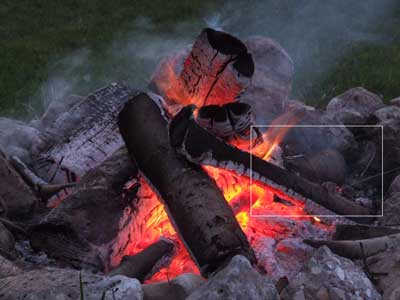
[Click to enlarge]
|
|
|
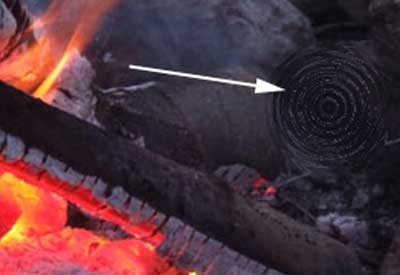
NASAPS artist's conceptualization of mini-rogue black hole, of the new
kind scientists have discovered in mountain ranges.
[Click to enlarge]
|
|
|
NASAPS scientists have determined that a new and startling breed of
micro-mini rogue black holes may be responsible for generating these
spectacular, but contained, light shows. “We
never thought this sort of thing was possible,” said
David Prill, of the University of Gloucester, “but
we've been wrong before.”
According to Dr. Prill, the discovery occurred by lucky accident.
“I was looking at photos of these
mysterious fires, when I happened to glance at a recent Hubble
telescope image of a quasar.” Dr. Prill explained.
“We have recently proved that
quasars are formed by the immense power of a black hole to generate
unpredictable light shows and hot radiation zones in space. Staring
at the photo of the fire in the mountains, I realized that a
mini-quasar was precisely what I was looking at, but on a much
smaller scale.”
Dr. Prill then went to his department chief and colleagues with
his discovery. “They were all
very excited – no one had ever considered this a possibility
before – black holes right here on earth. It was a radical notion,
but once we buckled down and did the math, it all began to fall
into place.”
|
|
|
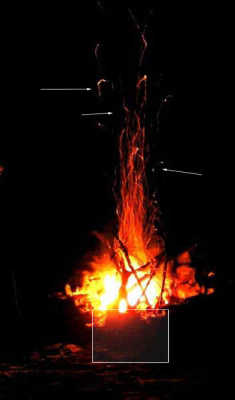
Scientists have highlighted (arrows) the explosive charged filaments
radiating outward. Scientists speculate that the mini-black hole's gravity
is so concentrated that it actually cannot consume all the matter that it
attracts, and that some matter is supercharged and flash-heated in a compression
flame, which extends from the mouth of the rogue mini-black hole. The
upward-spiraling filaments are radioactive particles of matter which were
stirred up in the black hole's pressure cooking 'accretion bulb,' and were so
stimulated by the immense conflagration of matter, that they bounce off violently.
[Click to enlarge]
|
|
|
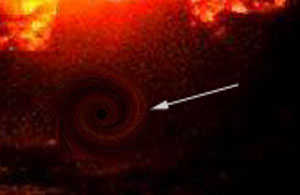
NASAPS artist's conceptualization of invisible black hole driving
hot air and gas into an explosive frenzy.
[Click to enlarge]
|
|
|
Skepticism among Peers
News about Dr. Prill's discovery have been greeted with some
skepticism from other astronomers. Dr. Felix Chandranakir of
the University of Bhopal, in India said, “It's
all well and good to blame these fires on a black hole, but
what about the wormhole that should be created?”
Dr. Chandranakir argues that the lack of evidence for the wormhole
indicates that these may not, in fact, be black holes, but rather
a new kind of celestial object, which he is calling
“gravity igniters.”
But Prill remains convinced by the evidence.
“At this point, we've collected
so much data that to say that these aren't mini black holes is tantamount
to saying that the Holocaust did not occur.”
But, he added, mysteries remain. For example, how does the
massive gravity stream draw in with so much force from such
a small area? It is known that these mini black holes do not
disrupt the local environment in collecting their matter at
light-speed. Prill believes that this is due to the mini-black
hole's ability to super-condense matter at its perimeter.
“It's like pulling a big
rope very slowly – you're still getting a lot of rope,”
he explains.
Puzzles Abound
But these tiny earthly celestial objects still present mysteries.
Dr. Prill:
We have searched
one hotspot [see image below]
with every imaginable instrument,
and we have not been able to find the black hole producing it.
But we're on the right track, because we finally know what we
are looking for. This is truly an illuminating and revolutionary
addition to what we now know about Black hole science.
|
|
|
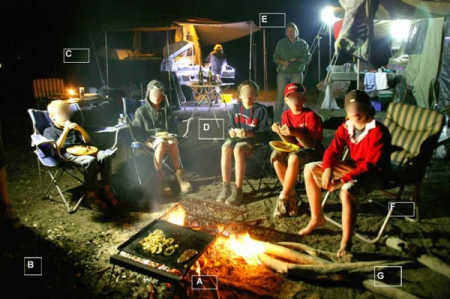
Possible black holes: A, B, C, D, E, F or G.
[Click to enlarge]
|
|
|
“One thing we do
know, was
that these boys have experienced what many of us Astronomers have
longed to live through – sitting in the presence of a real, functioning
Black Hole, with its myriad of known and predicted affects – the
slowing and speeding up of time, the mixing of space and time, the
shocks to our earth-bound sense of order and logic, the immense pull
of matter into a singularity, so powerful that it produces all manner
of explosion, light, radiation, glow, arc, fire, and sparking effects.
It must have been quite magical for them.
As to the danger presented by these rogue mini-black holes, Dr. Prill
takes a laissez-faire approach:
I
wouldn't worry, I think you'd probably have to get within a few
milimeters of the thing to be affected by its gravity – because
its gravity, like many black holes, is very local, and doesn't
affect most material around it – or it does, but in paradoxical
and unexpected ways. This is the one thing we've come to know
absolutely about black holes: they never behave as we'd thought
they would.
For the world of science fiction, this has been Liam Scheff reporting.
|
|
|
Permalink to this article.
Public comment may be made on this article on the
Thunderbolts Forum/Thunderblogs (free membership required).
|
|
|
|
|
|
|








